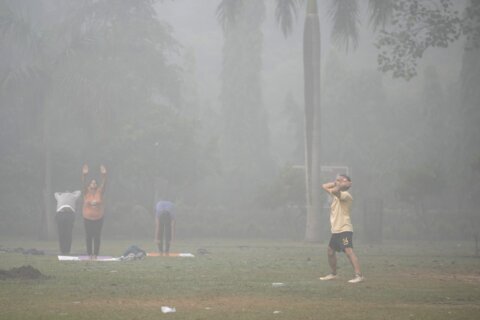Curricular Practical Training, or CPT, gives international students in the U.S. an opportunity to gain work experience directly related to their studies. For those who hope to gain work experience while studying in the U.S., it’s important to have a solid understanding of this training option.
Vaishali Gauba from India took part in CPT when she studied business management with a double major in journalism and media studies at Rutgers Business School–New Brunswick in New Jersey. Her CPT was in journalism internships over three semesters at CNBC, NBC and CBS News.
“I got real-time newsroom experience as a student,” Gauba says. “I was able to accompany reporters on field shoots, write for CNBC, NBC and CBS News, work with 60 Minutes news reporters and more. It was a dream come true.”
Here’s what prospective international students need to know about CPT, a type of off-campus employment authorization in which the work must be related to a program of study and must be completed before graduation.
CPT Program Eligibility
Experts say international undergraduate students who hold F-1 immigration status are eligible for CPT after they have been enrolled full time in a degree program for one full academic year. The one-year requirement does not apply to graduate students in F-1 status if their graduate program requires participation in CPT during the first year.
[Read: International Students: How to Maintain Visa Status]
“There are consistent general eligibility requirements, such as maintenance of valid F-1 status and practical training directly related to the degree program. However, federal regulations on CPT are quite vague, so it is up to each institution to develop its own CPT policy and procedure that match institutional policies and procedures,” says Samantha McCabe, international student services director at the University of Wisconsin–Madison.
Portland State University in Oregon has a few programs that require practical experience as part of the degree, says Christina Luther, director of the school’s Office of International Student and Scholar Services. Her office requires students interested in CPT opportunities to register for at least one academic credit during each term they are engaged in their practical training experience.
“This is not explicitly required by the Department of Homeland Security, but in order to be on the safe side, we require it,” Luther says.
Since CPT eligibility policies may vary among institutions, experts advise students to check with their school’s international student services office.
“Avoid comparing your friend’s experience at another U.S. institution, or even your own experience at a previous U.S. institution,” McCabe says, “because the CPT policies and procedures are likely to differ.”
Application Process
Each university may have varying application procedures, but the process typically begins when a student secures a work offer and then must complete the school’s CPT application, experts say. CPT covers various types of work experience, such as an internship, co-op or practicum.
“We ask students to allow three to five business days for ISSS to review and process a CPT request if the request is complete,” says Laura Buhs, assistant director of international student and scholar services at the University of Colorado Anschutz Medical Campus.
Luther says CPT applications often require follow-up. For example, offer letters may not contain required details, such as whether it is for part-time or full-time employment, employer’s name and address, work location and duration of an internship.
Luther says her office often gets incomplete offer letters, which can delay employment authorization. “So we recommend that they apply two weeks before their internship begins.”
[Read: International Students: What to Know When Failing to Make Academic Progress.]
Vietnamese national Minh Doan, who has a master’s in accountancy from the University of Denver in Colorado, says his CPT process was easy and straightforward. Although his graduate program did not require an internship, he participated in one for credit. The CPT process didn’t require a lot of application materials and it took only a few days to receive approval, he says.
“The fact that CPT is handled by individual universities rather than by the bureaucratic system of the government genuinely affects the efficiency of the process,” Doan says.
Buhs says the processing time for student requests at the University of Colorado Denver/Anschutz Medical Campus is 10 business days. McCabe says the average ISS application processing time for completed applications at the University of Wisconsin–Madison is about seven to 11 business days due to the school’s large population.
“It is always a good idea to review your ISS office policy on CPT to determine allowable CPT dates, course enrollment requirements and other relevant information so that all parties are prepared — student, employer, career, academic adviser and ISS,” McCabe says.
Priya Das, a third-year Ph.D. student from India studying chemical engineering at Rutgers University in New Jersey, started applying for jobs in early September 2024 for summer CPT. She applied to senior scientist, scientist, R&D systems engineer and design engineer positions in the health care industry.
“Since I’m an international student with no prior work experience in the U.S., this opportunity is important to me,” Das says. “I am seeking to work in the area of process control design of continuous manufacturing lines to gain some technical skills.”
The process is highly competitive, she says, and major companies begin the hiring process in early September with final offers made around late October to early November, so “starting early certainly helps,” she says. Once she gets a few offers, she will connect with her school’s international student affairs office to begin her CPT application.
[20 U.S. Colleges That Offer the Most Financial Aid to International Students]
Impact on OPT Eligibility
Experts say students can use as much CPT time as is required for their degree program. However, if they use a total of 12 months or more of full-time CPT, they are not eligible for Optional Practical Training.
OPT provides a 12-month work period for students on an F-1 visa to complete before or after graduation. Pre-completion OPT allows international students to hold a job during their studies, while post-completion OPT — the more popular option — allows them to work part time or full time after graduation.
“Per a federal regulation, students who do not exceed 365 days of full-time CPT are eligible for OPT, assuming they have met all other requirements,” Buhs says.
Full-time CPT is defined as more than 20 hours per week, McCabe says, noting that part-time CPT does not affect a student’s eligibility to apply for post-completion OPT. “However, it is important to understand that the U.S. Citizenship and Immigration Services reviews and adjudicates OPT applications, so it is ultimately their decision to authorize OPT.”
Luther says she has heard reports of USCIS counting part-time CPT authorizations along with full-time CPT authorizations toward the 12-month limit, but has not seen any resulting OPT denials.
“Because USCIS seems to be regarding CPT authorizations much more strictly, we are cautioning students about using too much CPT while they are within their programs of study,” she says.
Doan encourages international students who plan to pursue work training to familiarize themselves with CPT and says the simple CPT process means they “can focus completely on getting an internship.”
Gauba says the experience she gained through CPT internships made her a qualified candidate for a job at CBS News as a fresh graduate. She now runs her own public relations business, Vaishali Gauba Media Inc.
“The journalist bylines I got from this time at university are still an important and proud part of my portfolio,” she says, “and something I still use in my public relations business.”
More from U.S. News
What International Students Should Know About Financial Aid
What U.S. College Waitlists Mean for International Students
Considering the U.S. for College or Graduate School
Curricular Practical Training: What International College Students Should Know originally appeared on usnews.com







